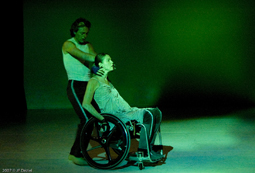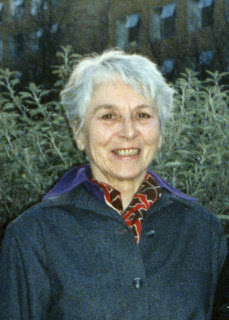These are the images I keep returning to from Crystal Pite’s “Dark Matters”: a wooden puppet kneeling devoutly; a lighting rig dangling precariously from the flies above the stage, which is in chaos; Jermaine Spivey’s bright split-leg leaps; and Pite’s careful sewing up of Peter Chu’s chest, her slender fingers pushing the (imaginary) needle in and out. Until then, Pite had been unrecognizable, shrouded in a black pant outfit and hoody, watching and manipulating the action — a figure of Fate or maybe the Deity herself. Finally, for this closing duet, Pite stepped out of her disguise, revealing a young woman in bra and panties, able to resurrect Chu, tugging him to her until they are in each other’s arms and the lights go out.
Their tumbling, seated duet, with Chu’s arched, vulnerable chest and Pite’s delicate hands and feet, is a marvelous finale: human and tender — erotic, too — yet pulling together all the threads of the piece so that it is thematically rich and provides an emphatic full stop to the evening. “Dark Matters” ends with the mysterious light of human connection and desire, and brought the audience at the sold-out Playhouse Theatre to their feet.
That duet is a long way from the start of “Dark Matters”, which opens with a spot searching the darkness. A precisely modulated English voice (actor Christopher Gaze) recites excerpts from Voltaire’s “Poem on the Lisbon Disaster”, written after the Portuguese city experienced the violent earthquake of 1755 that killed many thousands. There are references to being “devoured by death”, to “thinking atoms” and to the “temporary blend of blood and dust … put together only to dissolve.” The text — hard to process in one hearing — is repeated twice more throughout the piece, each time its thick, compelling imagery becoming a little clearer.
The whole work is like that – dense and dramatic, especially the forty-minute first act, which is a taut thriller, suspenseful and funny at the same time. The opening scenario involves a man (Chu) and a puppet — a small wooden figure he appears to have created one day in his kitchen, possibly while making a sandwich, and that is manipulated by four black-shrouded figures through long poles attached to its body. There is no attempt to hide the quartet, whose precisely calibrated teamwork allows the hinged puppet to walk, kneel, express affection and exact revenge. The puppeteers are, in fact, a key metaphor: figures of fate, or the ghost in the machine made visible, or forces of God and/or Nature.
The relationship between creator and created is central, but I don’t want to give the plot away – this whole act is driven by one surprise after another, a melodrama of murder and mayhem that is both touching and hilarious. Pite even manages to pull off a ninja-styled fight scene between the shadow puppeteers. It’s all well supported by Owen Belton’s pulsing score, laced with occasional thunder; Rob Sondergaard’s dark-night-of-the-soul lighting; and Jay Gower Taylor’s cozy but frighteningly collapsible kitchen set.
Act two features one shadow figure (revealed at the end to be Pite), with the rest of the excellent cast (Canadians Eric Beauchesne and Yannick Matthon, plus Americans Cindy Salgado, Spivey and Chu) now in street clothes. The space is cleared, the stage empty; the focus is no longer on storytelling, or the familiarity of joke fights. We have instead Pite’s hyper-articulated choreography: slides and shuffles, eruptions and pauses, limbs at surprising angles and flexible spines that are sometimes rounded like widow’s humps and at other times impossibly arched.
The themes of fate and freedom, and of the mysteries of our existence as “thinking atoms”, continue to be explored through the presence of that single shrouded figure who holds Salgado’s hand to help her step carefully across Matthon’s body and moves standing lights so they shine directly on the dancers. But there is a diffuseness to the action, with the momentum constantly halting as the dancers resolutely find ways to animate the less expected parts of the body: often elbows and knees, which seem hinged like the little puppet’s. Matthon and Spivey have a lovely duet with some refreshingly long, extended legs, and Spivey occasionally releases into space with a full and fabulous force — those split-leg leaps are gorgeous — but much of the movement resists any such flow. The abrupt changes of direction that seem motivated by intellect and not always sense become a little wearying despite top-notch execution.
“Dark Matters”, which premiered in Ottawa at the National Arts Centre in April 2009, was co-presented in Vancouver by DanceHouse and the 2010 Cultural Olympiad. The work has already toured to Australia and elsewhere in Canada, and is now set to travel to Europe and the United States. As it stands, and even with my reservations over the second act’s lack of narrative drive — or any other kind of clear forward drive — “Dark Matters” is a fabulous piece, serious and funny, the whole shebang of human existence distilled into two hours of entertaining dance and theatre.
With its brooding darkness leavened so beautifully with light, “Dark Matters” should add to the growing international reputation of Pite’s normally Vancouver-based company, which is now called Kidd Pivot Frankfurt RM. The “Frankfurt RM” part of the name is in place for at least the next two years while the company is supported through a German co-production, which involves Pite and her crack team spending some time in residency in Frankfurt. In the depressing arts funding climate of British Columbia, the European hospitality must be especially welcome.
Tagged: Contemporary, Performance, BC





